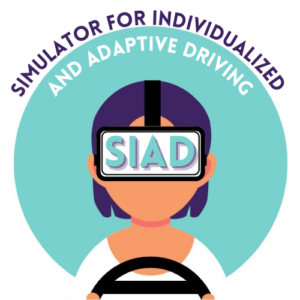Simulator for Individualized and Adaptive Driving (SIAD)

Personnel: Abigale Plunk, Devon Wilson, Nilanjan Sarkar
Outline:
Driving is an essential part of life for over 200 million people in the United States, where vehicle crashes are the number one killer of teenagers. While neurotypical drivers must be vigilant in an environment of distracted, aggressive, or inebriated motorists, drivers with neurodevelopmental disorders may present characteristics unconducive to optimally safe driving, exacerbating the challenge of driving. In the case of individuals with ASD, aspects such as atypical gaze processing and impaired motor coordination are likely to influence driving performance. However, it is only recently that researchers have begun to investigate driving performance in the ASD population. Given the risks of on-road driving assessment, driving simulators are a convenient alternative. Commercial driving simulation systems do not currently offer closed-loop adaptivity from modalities other than performance, such as eye gaze or physiology. To fill this gap, we developed SIAD – a virtual reality-based driving simulator that provides driving practice in a safe and encouraging environment with both real-time and offline feedback based on quantitative metrics.
SIAD presents various driving scenarios designed to challenge drivers on basic tasks, including turning, merging, and speed maintenance. Importantly, SIAD can be configured to adapt its internal parameters (e.g., difficulty) according to measured features of the driver’s physiological state or gaze patterns.
Video:
In the news: Vanderbilt Research News, STAT News, NBC News, and Autism Speaks.
Publications:
- J. Wade, A. Weitlauf, N. Broderick, A. Swanson, L. Zhang, D. Bian, M. Sarkar, Z. Warren, and N. Sarkar, “A Pilot Study Assessing Performance and Visual Attention of Teenagers with ASD in a Novel Adaptive Driving Simulator,” Journal of Autism Development Disorders, 47(11): 34015-3417, 2017.
- J. Wade, L. Zhang, D. Bian, J. Fan, A. Swanson, A. Weitlauf, M. Sarkar, Z. Warren, and N. Sarkar, “A Gaze-Contingent Adaptive Virtual Reality Driving Environment for Intervention in Individuals with Autism Spectrum Disorders,” ACM Transactions on Interactive Intelligent Systems (TiiS), vol. 6, Article 3, 2016.
- L. Zhang, J. Wade, D. Bian, J. Fan, A. Swanson, A. Weitlauf, Z. Warren, and N. Sarkar, “Cognitive load measurement in a Virtual Reality-based Driving System for Autism Intervention,” IEEE Transactions on Affective Computing, 2016.
- D. Bian, J. Wade, Z. Warren, and N. Sarkar, “Online Engagement Detection and Task Adaptation in a Virtual Reality Based Driving Simulator for Autism Intervention,” in International Conference on Universal Access in Human-Computer Interaction, 2016, pp. 538-547.
- L. Zhang, J. Wade, D. Bian, J. Fan, A. Swanson, A. Weitlauf, Z. Warren, and N. Sarkar, “Multimodal fusion for cognitive load measurement in an adaptive virtual reality driving task for autism intervention,” in International Conference on Universal Access in Human-Computer Interaction, 2015, pp. 709-720.
- J. Wade, D. Bian, J. Fan, L. Zhang, A. Swanson, M. Sarkar, A. Weitlauf, Z. Warren, and N. Sarkar, “A virtual reality driving environment for training safe gaze patterns: Application in individuals with ASD,” in International Conference on Universal Access in Human-Computer Interaction, 2015, pp. 689-697.
- J. Wade, D. Bian, L. Zhang, A. Swanson, M. Sarkar, Z. Warren, and N. Sarkar, “Design of a virtual reality driving environment to assess performance of teenagers with ASD,” in International Conference on Universal Access in Human-Computer Interaction, 2014, pp. 466-474.
- L. Zhang, J. W. Wade, D. Bian, A. Swanson, Z. Warren, and N. Sarkar, “Data Fusion for Difficulty Adjustment in an Adaptive Virtual Reality Game System for Autism Intervention,” in International Conference on Human-Computer Interaction, 2014, pp. 648-652.
- D. Bian, J. W. Wade, L. Zhang, E. Bekele, A. Swanson, J. A. Crittendon, M. Sarkar, Z. Warren, and N. Sarkar, “A novel virtual reality driving environment for autism intervention,” in International Conference on Universal Access in Human-Computer Interaction, 2013, pp. 474-483.
- M. Lei, G. Meng, W. Zhang, J. Wade, and N. Sarkar, “Brain Gamma Oscillations of Healthy People During Simulated Driving,” in International Conference on Intelligent Robotics and Applications, 2016, pp. 453-458.
- D. Bian, J. Wade, A. Swanson, Z. Warren, and N. Sarkar, “Physiology-based affect recognition during driving in virtual environment for autism intervention,” in 2nd international conference on physiological computing system (Accepted, 2015), 2015.
- J. Fan, J. W. Wade, D. Bian, A. P. Key, Z. E. Warren, L. C. Mion, and N. Sarkar, “A step towards EEG-based Brain computer interface for autism intervention,” in 2015 37th Annual International Conference of the IEEE Engineering in Medicine and Biology Society (EMBC), 2015, pp. 3767-3770.
- L. Zhang, J. Wade, A. Swanson, A. Weitlauf, Z. Warren, and N. Sarkar, “Cognitive state measurement from eye gaze analysis in an intelligent virtual reality driving system for autism intervention,” in Affective Computing and Intelligent Interaction (ACII), 2015 International Conference on, 2015, pp. 532-538.
Previously known as: VADIA: VR Adaptive Driving Intervention Architecture
Past Personnel: Joshua Wade, Dayi Bian, Lian Zhang, Jing Fan